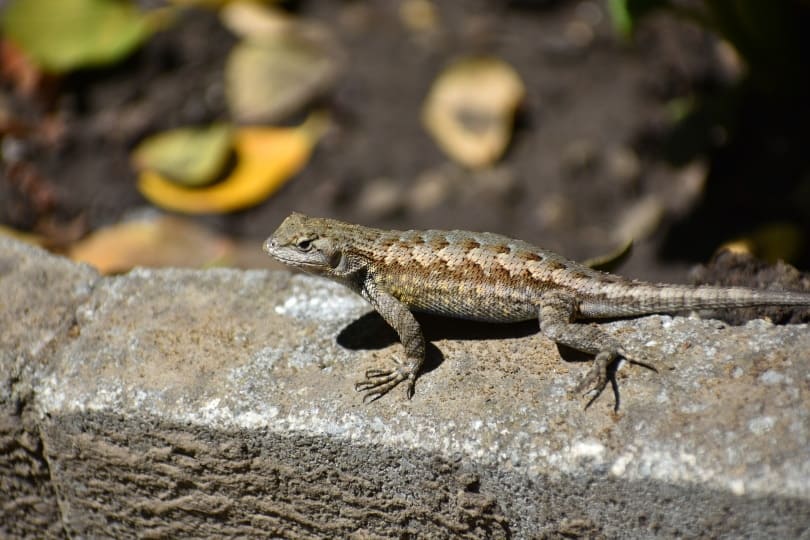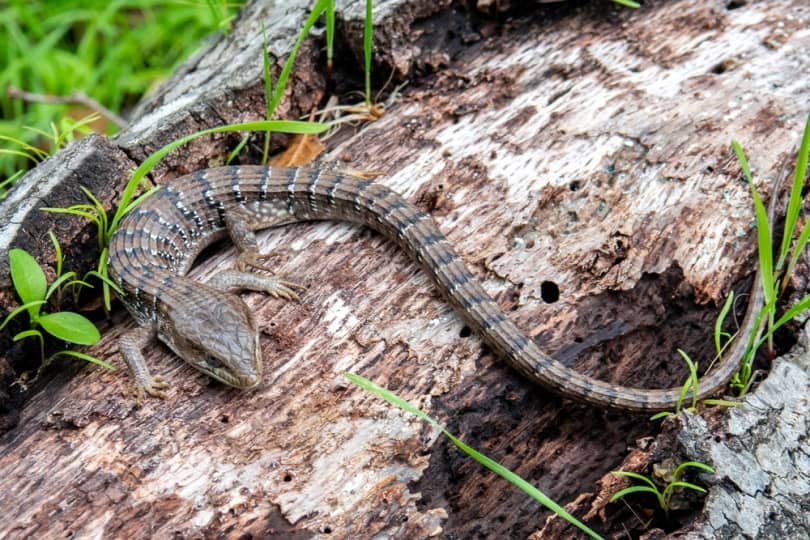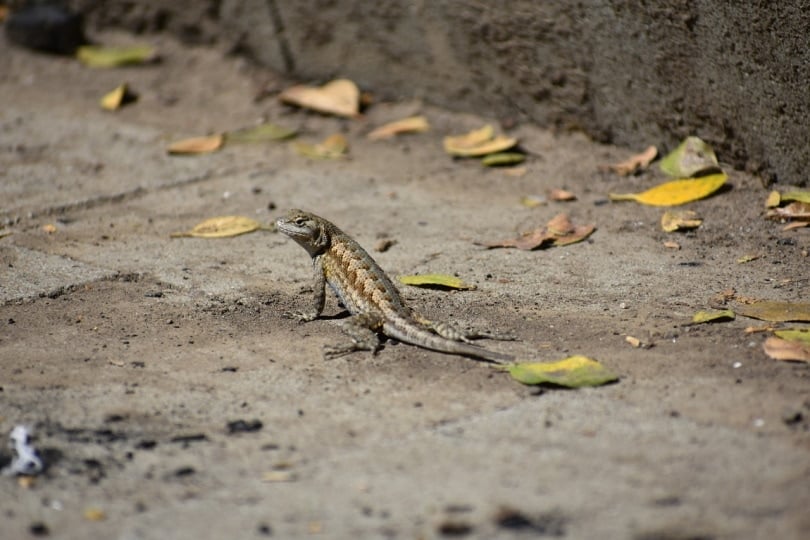Because Washington is such a diverse state with so many available environments, it’s no shock that there are seven lizards found in the state. You can easily find some of these lizards in cities, but some are more secretive and like to hang out in more natural areas.
Although you don’t have to worry about Washington lizards being poisonous or aggressive, it’s still a great idea to be cautious when approaching lizards. Since they’re so small and fragile, they don’t like being disturbed.
To learn more about the seven lizards found in Washington, keep reading.

The 7 Lizards Found in Washington
Washington state is home to seven types of lizards. To most residents’ delight, there are no poison lizards in Washington, just as there are no invasive lizards in Washington either. Instead, the majority are simply small lizards in the state that don’t cause any trouble to you, your family, or your furry friends.
1. Pygmy Short-Horned Lizard
| Species: | Phrynosoma douglasii |
| Longevity: | 5 years |
| Adult size: | 2.6 in. |
| Diet: | Insectivore |
| Habitat: | Open, shrubby, or woody areas |
As its name suggests, the Pygmy Short-horned Lizard is a small lizard with horns all over its body. You can find it in Washington state, but you can find it all around the northwestern United States and southwestern Canada.
Although the Pygmy Short-Horned Lizard is often mistaken for the Greater Short-Horned Lizard, they’re actually two distinct species. Luckily, it is pretty easy to differentiate the two since the Pygmy is so much smaller.
Oftentimes, the Pygmy Short-Horned Lizard is called a toad because it has a rather flat yet rotund body. In fact, its Latin name Phrynosoma literally means “toad body.” Despite looking like a toad, this lizard is a reptile, not a toad.
2. Sagebrush Lizard
| Species: | Sceloporus graciosus |
| Longevity: | 2 years |
| Adult size: | 2.4 in. |
| Diet: | Insectivore |
| Habitat: | Shrublands, coniferous forests, certain woodlands |
The Sagebrush Lizard is considered the most common species found at the mid and high altitudes throughout the western United States. It is named after the sagebrush plants these lizards are commonly found by.
In many ways, the Sagebrush Lizard is similar to the Western Fence Lizard, another lizard found in Washington state that we will look at shortly. However, this lizard is different because of its smaller size and finer scales.
Although you are most likely to find the Sagebrush Lizard in shrublands, you can also find it in coniferous forests and certain woodlands. They often like to bask on rocky outcrops and logs, but they spend most of their time on the ground.
3. Side-Blotched Lizard
| Species: | Uta stansburiana |
| Longevity: | 1 year |
| Adult size: | 2.2 in. |
| Diet: | Insectivore |
| Habitat: | Arid or semi-arid areas, scattered bushes, and trees |
The Side-Blotched Lizard is found in Washington, but it is more commonly found in the southwestern United States. In fact, these lizards can be found as far down as Mexico, making Washington one of its northernmost locations.
Side-Blotched Lizards are known to have a unique form of polymorphism. What this means is that all three male morphs attract mates differently. Each morph has its own advantages and disadvantages for breeding, which allows all three to survive.
Many scientists have compared their polymorphism to the game of rock, paper, scissors, in which each tool has an advantage over one but a disadvantage over the other. In the same way, each morph has both an advantage and disadvantage to the other two morphs.
4. Western Fence Lizard

| Species: | Sceloporus occidentalis |
| Longevity: | 5 – 7 years |
| Adult size: | 2.2 – 3.4 in. |
| Diet: | Insectivore |
| Habitat: | Grassland, woodland, sagebrush, farmland, some forests |
The Western Fence Lizard is the species we mentioned is often mistaken as the Sagebrush Lizard. Sometimes, these lizards are called Blue Bellies because they have distinctive blue bellies that look very iridescent.
They can be found as low as northern Mexico or as high as Washington. You can specifically find them in woodlands, grasslands, farmlands, and even coniferous forests, though they tend to avoid moist forests and harsh deserts.
Something that’s really unique about the Western Fence Lizard is that they have a special protein in their blood that can kill Lyme disease bacteria. Whenever an affected tick feeds on the lizard’s blood, the bacteria is killed, and the tick no longer carries Lyme disease.
5. Western Skink
| Species: | Eumeces skiltonianus |
| Longevity: | 10 years |
| Adult size: | 2.1 – 3.4 in. |
| Diet: | Mainly insectivore |
| Habitat: | Grassland, woodland, some forests |
One of the more unique lizards in Washington is the Western Skink. The Western Skink has short limbs, smooth scales, and a bright blue tail. The blight blue tail is unique because the skink can shed it whenever it is being attacked by a predator. Once the skink gets away, it can grow the tail back, but it will likely be a darker color and look misshapen.
Even though most people associate skinks with moist habitats, the Western Skink can be found in many types of environments, ranging from near-water habitats to open fields, but they tend to avoid heavy brush and forests.
The Western Skink is one of the more difficult lizards to find on this list. Even though they are common throughout the state, they’re very secretive and usually don’t come out whenever they detect someone around.
6. Northern Alligator Lizard
| Species: | Elgaria coerulea |
| Longevity: | 10 years |
| Adult size: | 3.9 in. |
| Diet: | Mainly insectivore |
| Habitat: | Grasslands, rocky openings in forests, bushy areas, minimally developed areas |
Now that we are getting to the bottom of our list, we are going to look at some of the larger lizards. The Northern Alligator Lizard is named because it almost has a body that resembles an alligator.
In comparison to lizards all over the world, the Northern Alligator Lizard is only grouped as a medium-sized lizard, but it is rather large in comparison to the lizards of Washington. Luckily, these lizards aren’t very aggressive. So, you don’t have to worry about them.
You are most likely to find Northern Alligator Lizards in grassy areas, rocky openings in forests, or bushy areas. They can live in some areas with low development, but they are rarely found in fully developed urban areas.
7. Southern Alligator Lizard

| Species: | Elgaria multicarinata |
| Longevity: | 15 years |
| Adult size: | 5.6 in. |
| Diet: | Mainly insectivore |
| Habitat: | Grasslands, rocky openings in forests, bushy areas, some creeks |
If you are specifically interested in big lizards in Washington, you are going to love the Southern Alligator Lizard. This lizard can grow to be 5.6 inches long, making it the biggest species in the state, though it is still medium-sized in comparison to all lizards around the globe.
Although the Southern Alligator Lizard is much bigger than the Northern, it is found in many of the same environments, including rocky openings in forests, grassy areas, or bushy areas. You will not find these creatures in urban developments, but you can sometimes find them basking along creeks.
You don’t have to worry about these creatures being aggressive either. Just like all of the other lizards on this list, it is rather docile and not poisonous.

Why Are There No Salamanders on This List?
If you have been in the state of Washington, you know that there are tons of salamanders, yet there are no salamanders on our list. The reason for this is rather simple. Salamanders are completely different from lizards, despite the fact that they look similar.
The most important difference between salamanders and lizards is that salamanders are amphibians whereas lizards are reptiles. As a result, you will need to consult a whole different source if you are looking for salamanders in Washington.
What Is the Conservation Status of Washington Lizards?
Even though animals around the globe are facing endangerment or extinction, every single lizard on this list is considered not at risk. In other words, none of these lizards face endangerment or extinction in the state, which is a major plus for Washington since many reptiles and amphibians are dying elsewhere.

Conclusion
Next time you go outside in Washington, try to spot one of these seven lizards. Of course, don’t try to disturb the lizard because it is probably enjoying its day just like you. Instead, watch from afar, even though these lizards are gentle and don’t have any dangerous mechanisms to be aware of. You might have to look really hard!
Featured Image Credit: LynnLockhart328, Pixabay
